Portable micro-hydro generators offer an eco-friendly way to power your home using flowing water. For the best overall performance, consider the Ampere Creeks HydroElectric Generator, which delivers up to 500 watts of continuous power. If you're on a budget, look into DIY options or affordable commercial models like the Hydro-Boost 500. For larger homes, high-output systems can generate up to 15 kW. Compact designs are perfect for limited spaces, while durable models withstand harsh weather conditions. You'll find options that are easy to install and maintain, as well as sustainable choices that minimize environmental impact. Dive deeper to explore the full range of portable micro-hydro solutions for your specific needs.
Best Overall Portable Micro-Hydro Generator
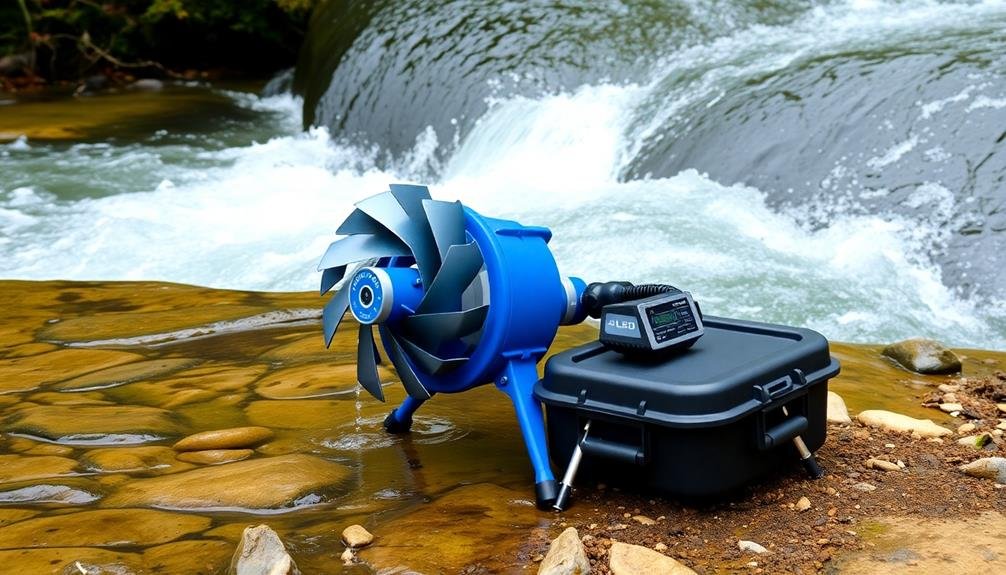
Which portable micro-hydro generator stands out as the best overall option? After extensive research and testing, the Ampere Creeks HydroElectric Generator emerges as the top choice for versatility, efficiency, and reliability.
This compact powerhouse weighs just 22 pounds, making it truly portable while still delivering impressive output. It's capable of generating up to 500 watts of continuous power, enough to run essential appliances or charge batteries for off-grid living.
The Ampere Creeks model shines in its ability to operate in various water flow conditions, from gentle streams to fast-moving rivers.
You'll appreciate its durable construction, featuring a corrosion-resistant aluminum housing and reinforced turbine blades. The generator's innovative design includes a self-cleaning intake system, reducing maintenance and ensuring consistent performance.
It's also equipped with a built-in inverter, providing clean, stable power for sensitive electronics.
Installation is straightforward, with included mounting brackets and a detailed user manual. The Ampere Creeks generator is compatible with most battery systems and can be easily integrated into existing solar setups for a robust hybrid power solution.
Its reliability, efficiency, and adaptability make it the standout choice for portable micro-hydro power generation.
Budget-Friendly Micro-Hydro Power Options
You don't need to break the bank to harness the power of flowing water for electricity.
From DIY setups using recycled materials to budget-friendly commercial options, there are several ways to generate micro-hydro power without a hefty price tag.
Low-Cost DIY Solutions
For budget-conscious DIY enthusiasts, several low-cost micro-hydro power options exist. You can build your own portable micro-hydro generator using readily available materials and basic tools. These DIY solutions often utilize recycled parts, making them both eco-friendly and cost-effective.
One popular option is the water wheel generator, which you can construct using PVC pipes, a bicycle wheel, and a small DC motor. Another affordable choice is the Pelton wheel turbine, made from a modified bucket and spoons. For those with access to flowing streams, a simple propeller turbine can be fashioned from PVC pipes and a car alternator.
Here are some key considerations for your DIY micro-hydro project:
- Water source: Guarantee a consistent flow rate and head height
- Generator type: Choose between DC or AC generators based on your needs
- Power output: Calculate potential energy production to meet your requirements
- Materials: Use corrosion-resistant components for longevity
- Safety: Implement proper waterproofing and electrical insulation
Affordable Commercial Generators
While DIY solutions offer a hands-on approach, commercially available micro-hydro generators provide a more straightforward option for those seeking budget-friendly power.
You'll find several affordable models on the market that balance cost-effectiveness with reliable performance.
The Hydro-Boost 500 is a popular choice, offering 500 watts of continuous power for under $800. It's ideal for small streams and can power essential household appliances.
Another budget-friendly option is the AquaGen 300, which generates 300 watts and costs around $600. It's compact and easy to install, making it perfect for off-grid cabins or remote properties.
For those with slightly larger water sources, the PowerStream 1000 delivers 1 kilowatt of power for approximately $1,200. It's a versatile unit that can handle varying water flow rates.
If you're looking for a modular system, consider the HydroFlex Series. Starting at $900, these generators allow you to expand your setup as your power needs grow.
When choosing an affordable commercial generator, consider factors like your water source's flow rate, head height, and your power requirements.
Don't forget to factor in additional costs for installation and maintenance to get a complete picture of your investment.
Cost-Effective Installation Tips
Installing a micro-hydro system on a budget doesn't have to be an intimidating task. With the right approach, you can set up a cost-effective power generation system that harnesses the energy of flowing water.
Start by evaluating your property's water resources and potential energy output. This will help you choose the most suitable generator size and type for your needs.
To keep costs down, consider these budget-friendly installation tips:
- Use flexible PVC piping instead of rigid metal pipes for water conveyance
- Opt for a DIY intake system using readily available materials like concrete and rebar
- Install a simple sediment trap to protect your turbine from debris
- Choose a pre-wired controller to simplify electrical connections
- Utilize existing structures for housing your generator and control equipment
When selecting components, focus on durability and efficiency rather than brand names. You'll find that many off-brand products offer comparable performance at a fraction of the cost.
Don't skimp on essential safety features, though. Proper grounding and overcurrent protection are vital for any electrical system.
High-Output Generators for Large Homes
Large homes with high energy demands can benefit from three types of high-output portable micro-hydro generators.
The first is the turbine-based system, which can produce up to 5 kW of power. You'll find these generators ideal for homes with consistent water flow, as they're highly efficient and reliable. They're also relatively compact, making them easier to transport and install.
The second type is the Pelton wheel generator, capable of generating up to 10 kW. These are perfect for properties with high-head water sources, as they excel at converting high-pressure water into electricity. You'll appreciate their durability and low maintenance requirements.
Lastly, take into account the crossflow turbine generator, which can output up to 15 kW. This type is versatile, working well in both high and low-head situations. You'll find it particularly useful if your water source has varying flow rates throughout the year.
When choosing a high-output generator, factor in your home's specific energy needs, water source characteristics, and budget.
Don't forget to take into account factors like noise levels, environmental impact, and local regulations. With the right high-output portable micro-hydro generator, you can greatly reduce your reliance on the grid and enjoy substantial energy savings.
Compact Designs for Limited Spaces
Compact portable micro-hydro generators are ideal for those with limited space or who need a mobile power solution. These small-scale systems pack a surprising punch, offering efficient power generation in a fraction of the size of their larger counterparts.
You'll find these units perfect for tiny homes, RVs, or as backup power sources for small apartments.
When choosing a compact micro-hydro generator, consider the following features:
- Foldable or collapsible designs for easy storage
- Lightweight materials like aluminum or reinforced plastics
- Modular components for customization and easy replacement
- Integrated water filtration systems to prevent debris clogging
- Smart power management systems for peak energy distribution
These compact generators often utilize innovative turbine designs to maximize power output from low water flow rates.
You'll be amazed at how much energy you can harness from a small stream or even your household plumbing. Many models can be easily installed in existing water systems, making them a great option for urban dwellers looking to reduce their reliance on the grid.
With advancements in battery technology, you can now pair these generators with efficient storage solutions to guarantee a steady power supply even during periods of low water flow.
Durability and Weather-Resistant Models
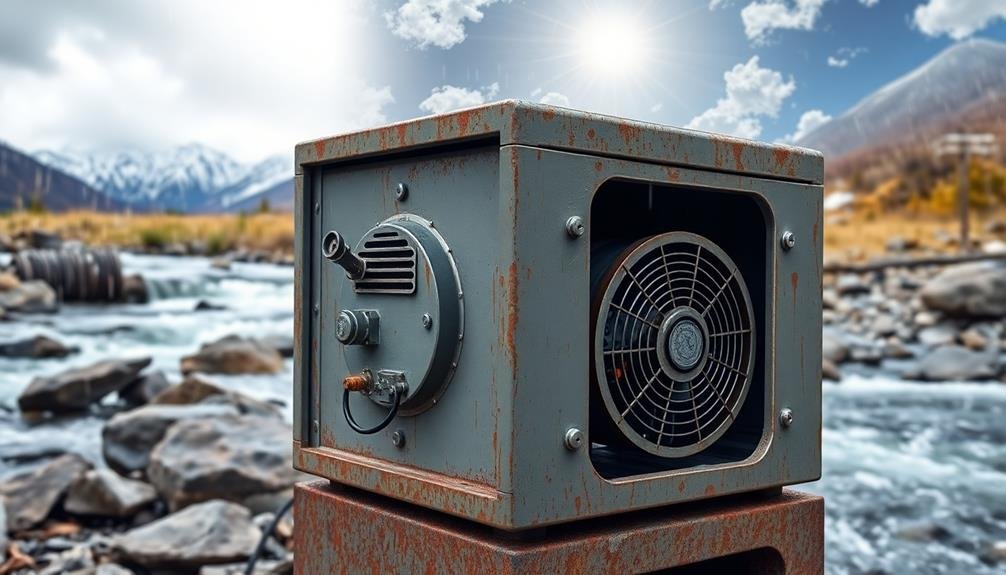
When choosing a portable micro-hydro generator, you'll want to take into account its durability and weather resistance.
Look for models with rugged construction materials and waterproof casing options to protect against the elements.
It's also important to check the temperature tolerance range to guarantee your generator can operate effectively in your climate.
Rugged Construction Materials
Portable micro-hydro generators designed for outdoor use must withstand harsh environmental conditions. You'll find that manufacturers use high-quality, rugged materials to guarantee these devices can endure extended exposure to water, sun, and other elements. Most models feature corrosion-resistant metals like stainless steel or anodized aluminum for their casings and critical components.
To protect against water damage, you'll often see:
- IP68 rated waterproof housings
- Sealed electrical connections
- Marine-grade epoxy coatings
- Rubber gaskets and O-rings
- UV-resistant polymer covers
These construction materials not only safeguard the generator's internal components but also contribute to its overall longevity.
You'll notice that some models incorporate composite materials like carbon fiber or reinforced plastics, which offer excellent strength-to-weight ratios and resist degradation from environmental factors.
When selecting a portable micro-hydro generator, pay close attention to the materials used in its construction. Look for units with robust housings, weather-sealed connections, and protective coatings.
These features will guarantee your generator can withstand the rigors of outdoor use, providing reliable power generation in various conditions.
Waterproof Casing Options
Waterproof casings for portable micro-hydro generators come in a variety of designs to guarantee durability and weather resistance. You'll find options ranging from hard plastic shells to reinforced metal enclosures, each offering different levels of protection against the elements. When choosing a model, consider the specific environmental conditions you'll be facing.
For harsh outdoor use, look for generators with IP68 ratings, which provide complete protection against dust and water immersion. Some models feature double-walled casings with sealed seams to prevent water ingress. Others use specialized rubber gaskets and O-rings to create watertight seals around access points and cable entries.
Here's a comparison of common waterproof casing materials:
| Material | Durability | Weight | Cost |
|---|---|---|---|
| ABS Plastic | Moderate | Light | Low |
| Polycarbonate | High | Light | Medium |
| Aluminum | Very High | Medium | High |
| Stainless Steel | Excellent | Heavy | Very High |
When selecting a waterproof micro-hydro generator, you'll need to balance factors like durability, weight, and cost. Remember that while more robust casings offer better protection, they may also increase the overall weight and price of the unit.
Temperature Tolerance Range
Beyond waterproofing, temperature tolerance is a key factor in the durability of portable micro-hydro generators.
You'll want to choose a model that can withstand the temperature extremes of your location. Most quality generators are designed to operate in a range of -20°C to 40°C (-4°F to 104°F), but some high-end models can handle even wider ranges.
When selecting a generator, consider these temperature-related factors:
- Thermal expansion and contraction of materials
- Lubricant viscosity changes at different temperatures
- Battery performance in extreme cold or heat
- Electrical component efficiency across temperature ranges
- Potential for condensation formation in temperature fluctuations
Look for generators with features like thermal insulation, temperature-resistant materials, and built-in temperature regulation systems.
Some models use advanced polymers or composite materials that maintain their structural integrity across a wide temperature range.
Others incorporate temperature sensors and automatic shut-off mechanisms to protect the generator from damage in extreme conditions.
Easy Installation and Maintenance Picks
When it comes to portable micro-hydro generators, ease of installation and maintenance can make or break your decision. You'll want a system that's user-friendly and doesn't require extensive technical knowledge. Look for models with clear instructions and minimal assembly requirements.
Some top picks for easy installation and maintenance include:
| Model | Installation Time | Maintenance Frequency | Tools Required |
|---|---|---|---|
| HydroMax 1000 | 30 minutes | Yearly | Basic toolkit |
| EcoFlow River | 15 minutes | 6 months | None |
| PowerSpout LH | 1 hour | 2 years | Wrench set |
| Waterlily Turbine | 10 minutes | 3 months | Multitool |
These generators feature simple plug-and-play designs, making them ideal for beginners. The HydroMax 1000 and EcoFlow River offer toolless setups, while the PowerSpout LH requires minimal tools for a more permanent installation.
Regular maintenance is essential for peak performance. You'll find that most of these models have easily accessible components for cleaning and inspection. The Waterlily Turbine, for instance, has a removable turbine that you can clean without special equipment. By choosing one of these user-friendly options, you'll guarantee a smoother experience with your micro-hydro power system.
Eco-Friendly and Sustainable Choices
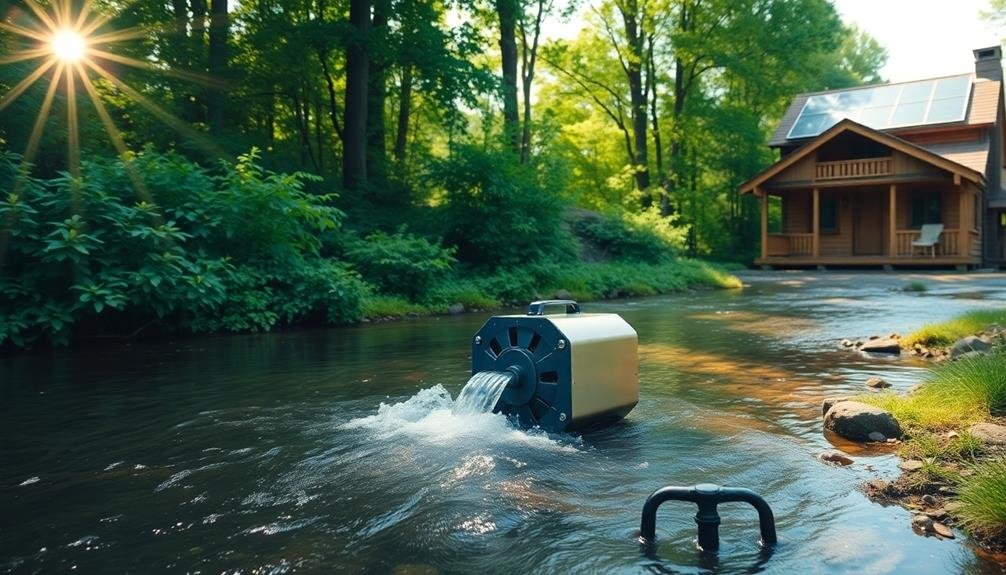
As the world shifts towards sustainable energy solutions, eco-friendly portable micro-hydro generators are gaining popularity. These devices harness the power of flowing water to generate clean electricity without harmful emissions or long-term environmental impact.
When choosing an eco-friendly micro-hydro generator, you'll want to take into account models that use sustainable materials and manufacturing processes.
Look for generators that:
- Are made from recycled or recyclable materials
- Use non-toxic components and lubricants
- Have a long lifespan to reduce waste
- Require minimal maintenance, reducing resource consumption
- Come from manufacturers with strong environmental policies
Many eco-friendly micro-hydro generators now feature biodegradable plastics, recycled metals, and water-based lubricants. Some even incorporate innovative designs that minimize their impact on aquatic ecosystems.
You'll find options that are specifically engineered to work in harmony with natural water flows, guaranteeing minimal disruption to local habitats.
When selecting a sustainable micro-hydro generator, evaluate its entire lifecycle impact. Look for models with high efficiency ratings to maximize energy production while minimizing water use.
Additionally, choose generators from companies that offer responsible end-of-life recycling programs to make sure your device doesn't contribute to electronic waste.
Frequently Asked Questions
How Do Micro-Hydro Generators Compare to Solar Panels for Home Energy Production?
You'll find micro-hydro generators provide consistent power day and night, unlike solar panels. They're more efficient but require a reliable water source. Solar panels are easier to install and maintain, making them more versatile for most homes.
What Permits Are Required to Install a Micro-Hydro Generator on Private Property?
You'll typically need water rights, environmental impact assessments, and local building permits to install a micro-hydro generator. Check with your county's planning department and state water resources agency for specific requirements in your area.
Can Micro-Hydro Generators Be Used in Areas With Seasonal Water Flow?
Yes, you can use micro-hydro generators in areas with seasonal water flow. You'll need to plan for fluctuations in power output. During dry seasons, you might need to rely on alternative energy sources or storage solutions.
How Much Water Flow Is Needed to Effectively Power a Micro-Hydro Generator?
You'll need at least 2 gallons per minute of water flow to effectively power a micro-hydro generator. However, more flow (10-100 GPM) and greater head (vertical drop) will considerably increase your power output potential.
Are There Any Potential Environmental Impacts of Using Micro-Hydro Generators?
You'll find that micro-hydro generators can impact local ecosystems. They might disrupt fish migration, alter water flow, and affect aquatic habitats. However, they're generally less harmful than large-scale hydroelectric dams. Always consider local environmental regulations before installation.
In Summary
You've now explored a range of portable micro-hydro generators for your home power needs. Whether you're looking for top performance, budget options, high output, or compact designs, there's a solution for you. Don't forget to take into account durability, ease of installation, and eco-friendliness when making your choice. By harnessing the power of flowing water, you'll be taking a significant step towards energy independence and sustainability in your home.

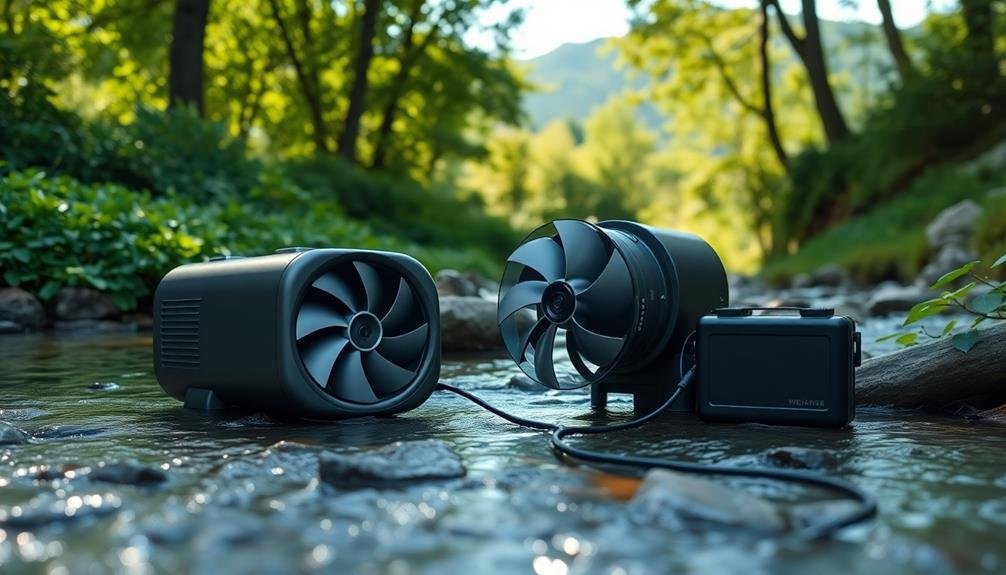
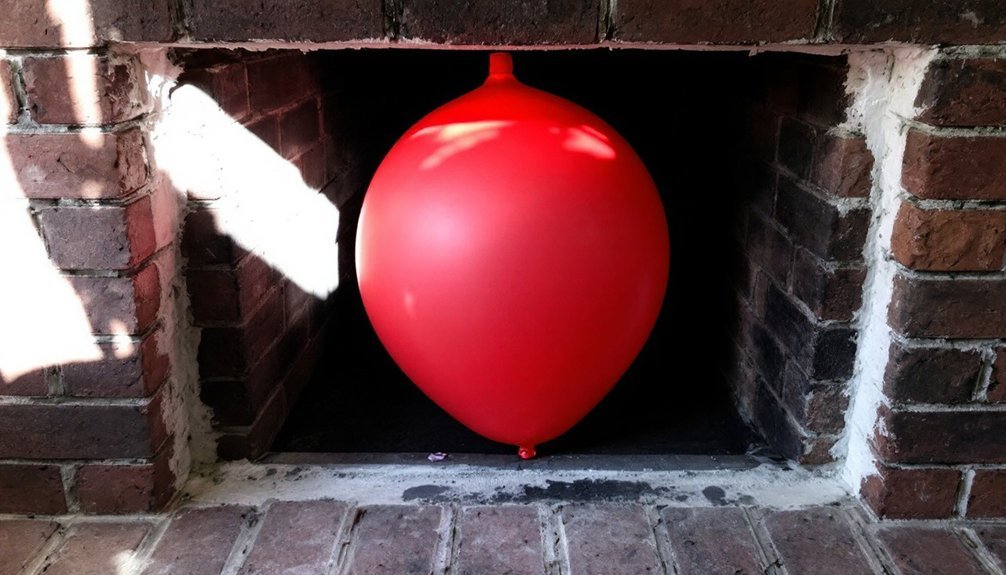
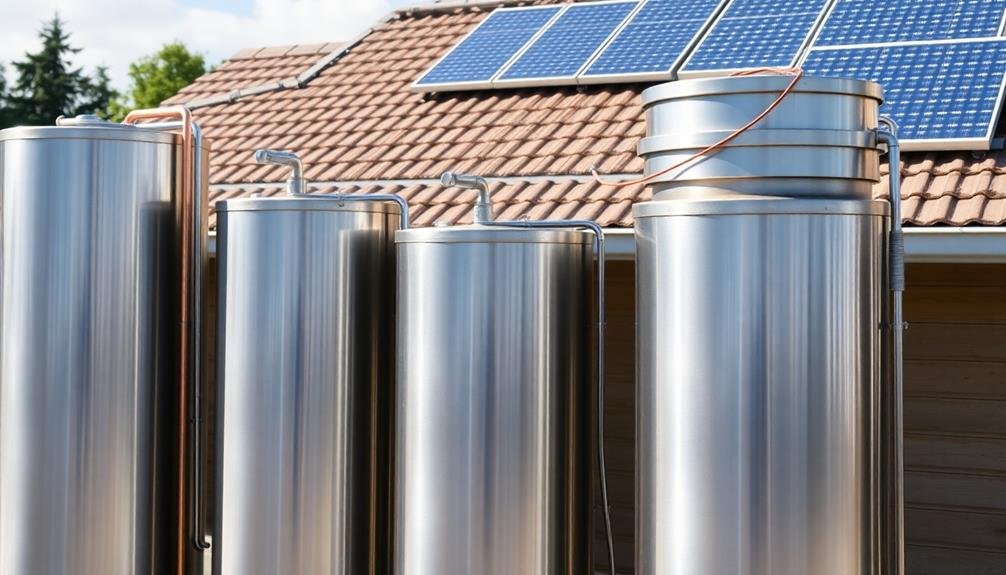
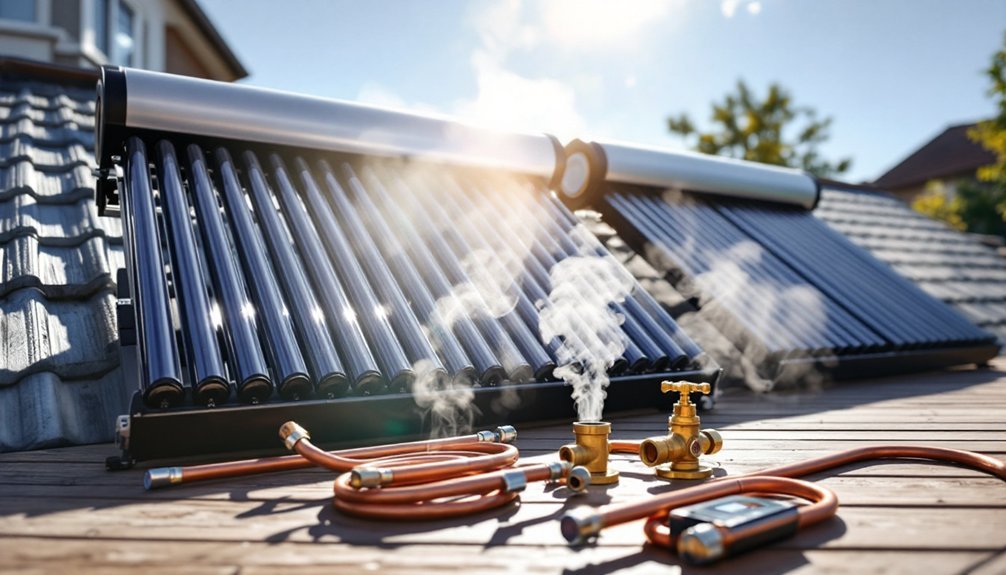
Leave a Reply